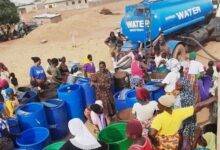
A report on Ghana’s implementation of the Sustainable Development Goals (SDGs) says menstruation remains a major contributor to school absenteeism and dropout among girls, particularly in rural areas.
This is a result of a myriad of challenges, including the increasing cost of sanitary materials, which makes the girls resort to unhygienic materials, and suffer menstrual pain and related health issues.
Others challenges mentioned in the report compiled by the National Development Planning Commission (NDPC), are fear of staining oneself and the perceived stigma; the absence of a sick bay or rest area to help girls rest during painful menstrual cramps.
No or limited access to water and sanitary facilities; washrooms not disability friendly for Persons With Disabilities; and lack of convenient places to dispose of used sanitary materials were also named in the 2022 Voluntary National Review (VNR) Report.
The issue of menstruation was captured under SDG Goal 4 on quality education, which enjoins UN member states to “Ensure inclusive and equitable education and promote lifelong learning opportunities for all.”
The findings of the report comes at a time various Civil Society Organisations are advocating the scrapping of the 20 percent tax on sanitary pads as it was a disincentive to promoting the sexual and reproductive health rights of women and girls in the country. A pack of sanitary pads, depending on the brand, cost between GH¢10 and GH¢15.
At the Menstrual Hygiene Day (MH Day) celebration on May 28, this year, for instance, discussants at a forum proposed that the government invest in alternative local materials and support the local industries to produce affordable and easily accessible pads.
Aside from menstruation hindering education of students, the VNR Report said school completion rate in Ghana had improved at all levels due to education strategies.
It said since the 2016/2017 academic year, approximately all pupils stay and complete primary education.
At the primary school level, it said, completion rates from 2018/2019 to 2020/2021 academic years exceeded 100 percent largely due to repetitions.
“The situation in Junior High School (JHS) has also improved, reaching 83.1 percent in 2020/2021 academic year albeit missing the national target of 92.0 percent for the academic year.
“The completion rates recorded at the JHS level indicates that a significant number of students drop out from school,” the report stated.
According to the document, the total number of schools increased across all the levels of education with an additional 2,849 schools established between 2018 and 2021.
The highest addition was for kindergarten 1,146, followed by primary 1,035 and the least was Senior High Schools with three additional schools.
The 2030 agenda for SDGs or 17 SDGs was adopted by all United Nations (UN) member states in 2015 and provided a shared blueprint for peace and prosperity for people and the planet.
The 2022 VNR report, launched last month and being discussed at various regional fora projected Ghana’s success and challenges across the various SDGs.
BY JONATHAN DONKOR






